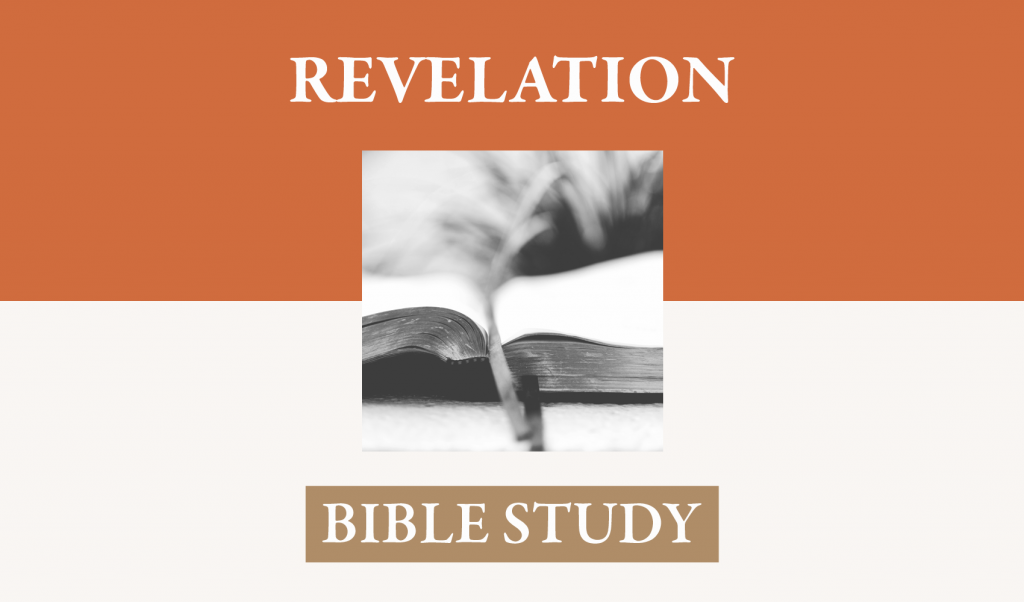Week of March 5, 2017
The Point: Jesus Christ is the victorious Lord of all.
Vision of the Exalted Christ: Revelation 1:12-20.
[12] Then I turned to see the voice that was speaking to me, and on turning I saw seven golden lampstands, [13] and in the midst of the lampstands one like a son of man, clothed with a long robe and with a golden sash around his chest. [14] The hairs of his head were white, like white wool, like snow. His eyes were like a flame of fire, [15] his feet were like burnished bronze, refined in a furnace, and his voice was like the roar of many waters. [16] In his right hand he held seven stars, from his mouth came a sharp two-edged sword, and his face was like the sun shining in full strength. [17] When I saw him, I fell at his feet as though dead. But he laid his right hand on me, saying, “Fear not, I am the first and the last, [18] and the living one. I died, and behold I am alive forevermore, and I have the keys of Death and Hades. [19] Write therefore the things that you have seen, those that are and those that are to take place after this. [20] As for the mystery of the seven stars that you saw in my right hand, and the seven golden lampstands, the seven stars are the angels of the seven churches, and the seven lampstands are the seven churches. [ESV]
“Vision of the Exalted Christ [12-16]. (1) Contents [12-13a]. The key is the verbal unit, turned to see, with its double accusative, seven golden lampstands … and one like a son of man. Since the commissioning voice was originally behind John [10], it was natural that he turned around. The action of “turning around” is given special emphasis by the repetition of the verb in the second clause with the temporal participle, on turning. John’s intention was to see who was speaking. The first thing he sees, however, is not the voice itself but seven golden lampstands. The lampstand was not a candleholder but a stand on which lamps were set. The lamp was normally an oil lamp with a single hole through which the wick protruded. The Old Testament imagery is varied. The basic passage is Exodus 25:31-40, in which Moses is commanded to make a lampstand of pure gold for the Holy Place with seven branches and lamps resting on the lampstand, the sacred menorah that became a symbol of Judaism. In 1 Kings 7:48-49 Solomon placed ten separate lampstands in the Holy Place, five on each side of the altar of incense, possibly to indicate completeness. Finally, Zechariah 4:2,10 is the Old Testament passage most closely related here, especially as it was already alluded to in 1:4. In 4:2 Zechariah is given a vision of a seven-branched gold lampstand with seven lips on each of the lamps (either channels for the oil to get to the lamps or spouts in which the wicks are set), and in 4:10 the seven (probably the seven lamps) are defined as the eyes of the Lord, which range through the whole earth. There are two differences between Zechariah and Revelation 1:12: in the latter there are seven separate lampstands, and on the basis of 1:20 they refer to the seven churches in chapters 2-3. Nevertheless, the basic thrust is the same: the churches are depicted as shining lights for God in the midst of a hostile world. Christ, the key figure that will dominate the rest of the chapter, is now introduced [13]. First, He is in the midst of the lampstands. This begins a progression of images, with Jesus in the midst of the lampstands [13], then holding in his right hand … seven stars [16; 2:1; 3:1], and finally walking among the seven golden lampstands [2:1]. All three images depict Christ involved in the lives of His people and sovereignly protecting them. There can also be a warning involved here. Since Christ is lord over the church, He can remove them if they do not turn themselves around [e.g., 2:5]. The one who is with His people is now described in terms drawn from Daniel 7:13, one like a son of man. This is the second thing that John saw in his vision. There is an obvious connection with the “Son of Man” sayings in the Gospels, where there is a connection with the exalted Danielic image. The figure in Daniel 7:13 is not human but is like a son of man, and he will reign over the people of God in the same way that the beasts rule the earth [Dan. 7:2-8]. The son of man image in Daniel, the Gospels, and Revelation was a messianic figure with divine overtones. (2) Description of the Glorified Christ [13b-16]. Eight successive images are drawn from the Old Testament and intended to introduce themes that will carry through the rest of the Book of Revelation. This dynamic picture is not meant as a literal description but rather a metaphorical image. We are not meant to put all this together as a picture of Jesus: white hair, blazing eyes, bronzed feet, thunderous voice, a sword coming out of His mouth. The accumulated images portray not His visage but His power and glory. These associations were obvious to John’s readers, who had grown up within the milieu of such images. We have not, so the evocative pictures still need to be unpacked for us, and we must keep our eyes on the whole and not just the parts. Verses 14-16 are grammatically linked and build on verse 13. Verse 14 contains a series of “and” clauses that provide further descriptions of the one like a son of man. Yet the whole of verses 14-16 elaborate the first description of verse 13. While several Old Testament texts have been woven together, Daniel 10:5-6 stands out, as the description follows a similar order: first the clothing, moving from the linen to a belt of gold, then the hair followed by the flaming eyes, the legs like bronze, and the powerful voice. The long robe and the golden sash could refer to the robe and sash of the high priest or it could refer to the robe and sash that dignitaries and rulers wore. Either way the first description depicts Christ as an exalted, dignified figure. The white hair on his head is another example of using Old Testament descriptions of God for Jesus, thereby stressing further the unity between the Father and the Son. In Daniel 7:9 it is said of the Ancient of Days: the hair of his head like pure wool. In ancient culture white hair indicated both dignity and the accumulated wisdom of years of experience. Moreover, white wool points to one of the major industries of the region, the wool industry of Laodicea. The wool and the snow together picture pure, dazzling whiteness. Christ in this simile is pictured in His eternal wisdom and in the respect due His person. The image of His eyes being like a flame of fire stems from Daniel 10:6 and will be repeated in Revelation 2:18 and 19:12. Most scholars note the extent to which this pictures the divine insight that penetrates to the core of the human situation. As in Daniel, however, this goes beyond that to include also the fierce judgment of the God who knows and acts against those who disobey Him. That is the context of 2:18 and 19:12. The image of bronze feet is closely related to Christ’s blazing eyes in both Daniel 10:6 and Revelation 2:18. This image of burnished bronze emphasizes the glory and strength of Christ. It is further clarified by refined in a furnace. The picture is probably that of a kiln in which the metal was brought to white-hot heat in order to refine or purify it. Since feet in the ancient world portrayed the direction of one’s life, the image here depicts Christ’s life in both its strength or stability and its absolute purity. With the influence of Revelation 2:18, which utilizes this image in the context of judgment upon the cult followers of Jezebel, it is also possible that this strength and purity are part of divine justice on the ungodly and apostate. This would fit the military imagery behind this symbol. It signifies not only glory and strength but warns of potential judgment. With the reference to his voice was like the roar of many waters, John again draws on Old Testament descriptions of Yahweh to show Christ in His divine glory and power. This detail stems from Ezekiel 1:24 and 43:2. The image is that of power and strength, the awesome voice of God. In his right hand he held seven stars. The right hand throughout Scripture symbolizes power and authority. To “hold” something means in one sense to “acquire” or “take possession” of the thing and in another sense to “keep” or “preserve” the thing. Probably both ideas (possessing and protecting) are intended here. To hold something in your right hand denotes power over the thing held. Thus the glorified Christ is in complete control. The seven stars are identified in verse 20 as the angels of the seven churches addressed in chapters 2 and 3. From his mouth came a sharp two-edged sword. This image shows that the primary image in holding the seven stars above is not so much protection but control, here with the added idea of judgment. The mouth of the Messiah from which the sword comes forth portrays the proclamation of judgment, with the act of judgment (the sword) immediately following. His face was like the sun shining in full strength. This final picture sums up the others. It recalls Moses when he came down from Sinai and his face was radiant, because he had spoken with Yahweh. Also, John had been present at Jesus’ transfiguration when his face shone like the sun, and his clothes became white as light [Matt. 17:2]. God is called a sun and shield in Psalm 84:11, and in Isaiah 60:19 we are told, the Lord will be your everlasting light. Once more an Old Testament image of Yahweh is applied to the glorified Christ. In light of the “sword” imagery in the previous description, the twin themes of glory and judgment may well be connoted here. The glory theme is predominant, with the judgment motif secondary.
Commission Expanded [17-20]. (1) Person of Christ [17-18]. As in theophanies throughout the bible, John fell at his feet as though dead. Falling down before visions of the Deity or His angelic messengers was a common reaction. John’s reaction heightens the sense of apocalyptic power, for God/Christ is indeed present in all His glory. The natural reaction in the face of an epiphany is to fall to the ground in fear, and John does so several times in the Apocalypse [1:17; 19:10; 22:8]. It is even more common to fall down in worship [4:10; 5:8,14; 7:11; 11:16; 19:4], and this could also be connoted here, though the fear aspect is certainly uppermost. This is certainly the voice of Christ that John hears. When Jesus touched John, there was both comfort and reassurance being given. First, He places His right hand, the one that held seven stars, on John. It is likely that the image of power and control is intended in this passage. Second, throughout the Bible “laying on the hand” is a commissioning act invoking as well as passing on authority and power. It is hard to say how much of that imagery is intended here, but the use of the right hand would favor seeing some of this thrust in this passage. The commissioning with authority to write fits the language chosen and the context. Christ begins by commanding, Fear not, a present tense prohibition meaning “stop being afraid.” There is no need to fear the presence of God when one is serving Him. This is a common response in the face of the fear caused by theophany. The basis of the reassurance, however, is who Jesus is. First, the description of God from 1:8 is here applied to Christ. Also, as we will see, many of the titles are utilized throughout Scripture as titles of God. Therefore, a major purpose is to establish the deity of Christ. Jesus is described as I am the first and the last. This title derives from Isaiah 41:4; 44:6; 48:12, where it refers to God as creator of all and sovereign over history. God precedes all things, as their Creator, and He will bring all things to eschatological fulfillment. He is the origin and goal of all history. He has the first word, in creation, and the last word, in new creation. In the context of Revelation 1:17-18, this sovereignty is now extended to Christ. The addition of the living one to the first and the last here in 1:18 tells us that the primary thrust of the previous title is not so much sovereignty as eternality. This title itself is a common designation of God in the Bible. In the Old Testament the title is in antithesis to the idols/pagan gods that have no life or power. In Revelation it is in contrast to the evil powers that control only Death and Hades. It is God and Christ alone who are eternal and make it possible to dwell in eternal bliss. This eternality is exemplified particularly in the death and resurrection of Jesus, for as Paul argued in 1 Corinthians 15:14, if Christ has not been raised, then our preaching is in vain and your faith is in vain. The contrast between dead and alive is intended to highlight not just the death-resurrection but even more to emphasize the reality of His eternality. He was dead, but now He is alive forevermore, the strongest possible reference to eternity and the form used throughout this book. The final description of Christ refers to His power over the cosmic forces. This was hinted at in the previous clause, died, and behold I am alive, since Death is one of the powers referred to here. Both in Hellenistic thought and in the Bible Hades is the realm of the dead, often the grave. The emphasis on the keys follows Jewish and Hellenistic thought. Christ through His death and resurrection has defeated the powers of evil (the twin forces of Death and Hades) and gained control over them by possessing the keys. In the New Testament, key in an eschatological text always has the idea of power or authority over a thing [cf. Matt. 16:19; Rev. 1:18; 3:7; 9:1; 20:1]. Thus here He has overcome and gained mastery over the cosmic forces. (2) Commission to Write Expanded [19]. The basic commission was given in 1:11, commanding John to write down the visions and indicating the recipients of that inscription. Here the commission relates the contents of the visions. Therefore draws a conclusion from the preceding statement. In light of Jesus’ cosmic victory over death and the forces of evil, John must write down what God is telling him. The three clauses: things that you have seen, those that are and those that are to take place after this, are parallel to the title for God in verse 4: who is and who was and who is to come. Thus they relate to the eschatological perspective of the book as a whole. All three clauses relate to the past, present, and future orientation of the entire book. (3) Interpretive Key [20]. At key points in this book [cf. 7:13-14; 14:4-5; 17:7-18; 19:8b; 21:9-14; 22:6] angels and others mediate the visions and provide critical interpretive keys to the meaning of the symbols. Here two parts of the vision are chosen for interpretation – the lampstands and the stars. From these the meaning of the whole can be derived. It is clear that the focus is not only on who Christ is but also on the churches themselves as the recipients of the mystery. The concept of mystery is a critical apocalyptic concept not only for this book but for the early church as a whole. It refers to hidden secrets kept from the people of the past but now disclosed by God. In the Book of Revelation the full meaning can be seen [10:7; 17:5,7], but in 1:20 it refers in less grandiose fashion to the meaning of these two key symbols from the first vision. Yet it still means more than just “symbol”, for the vision as a whole is an apocalyptic mystery on Christ and the church. The first symbol explained leads into the seven letters of chapters 2 and 3, each of which is addressed to the angel of the church. The meaning of the angel is highly disputed. The various options separate themselves into two sets centering on angels and human church representatives, respectively. The solution is not simple. To begin with, the use of angel in this book makes it extremely unlikely that these are human messengers of any type. Stars were a symbol both of dominion and of angels. These stars were the angels in charge of each church but were also corporately identified with the churches. In one sense they were asked to intervene in the spiritual needs of the churches; in another sense they represented the churches. The second symbol, lampstands, is built on the Jewish menorah or seven-branched lampstand and refers to the seven golden lampstands of 1:12, identified here as the seven churches of 1:11. The connection between the angels and the churches will be evident in the next two chapters, and the critical point here is that Christ is in charge of both. In 1:13 Christ is in the midst of the lampstands, and in 1:16 he held the seven stars in his right hand, with the latter mentioned again here for emphasis. In both cases the point is that Christ is in control, sovereign over the angels and the churches they represent and serve. In the midst of their precarious situation in an evil world that both despises and persecutes them, Christ is with them, protecting and vindicating them. At the same time He holds them accountable to persevere and remain faithful throughout their ordeal, as we will learn in each of the letters.
Questions for Discussion:
- John uses eight images drawn from the Old Testament to describe the glorified Christ in verses 13b-16. List the images. What do they mean? What picture of Christ do you receive from these images?
- What further information concerning the glorified Christ does John provide in verses 17-18? What does Christ do and say? What do the seven stars and seven lampstands represent [20]? Why is it important that Christ holds the stars in His right hand and is in the midst of the lampstands?
- God is the Alpha and Omega, and Christ is the first and the last, the force behind all human history. How do the sovereignty of God and Christ and their continued presence with their people help believers to view the challenges and suffering that come into their lives?
References:
Revelation, G. K. Beale, Eerdmans.
Exposition of the Book of Revelation, Simon Kistemaker, Baker.
Revelation, Grant Osborne, ECNT, Baker.





















